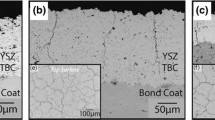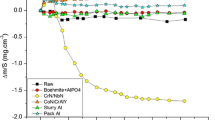Abstract
An oxide fluxing model involving continuous dissolution and reprecipitation of oxide scales via a thermal surface tension effect is postulated to explain hot corrosion of high teperature alloys and coatings in gas turbines. It is demonstrated that due to the existence of a thermal surface tension gradient, a molten alkali salt film condensed on a turbine vane or blade can undergo a circulating flow motion. A cycle of oxide dissolution at the hot end of the molten salt film and reprecipitation at its cold end can thus be established continuously to remove the protective oxide scales from the surfaces of the turbine components. Under gas turbine operating conditions, the liquid salt film can flow at a velocity as high as 1.5 cm sec−1, and the oxide scale can be continuously fluxed away at a rate over 1.5 mgcm−2h−1 (∼5 microns per hour for Al2O3). This can, therefore, be one of the mechanisms to sustain hot corrosion, especially under conditions where large surface temperature gradients are encountered.
Similar content being viewed by others
References
N. S. Bornstein and M. A. Decrescente, Trans. TMS-AIME 245 (1969) 1947.
J. A. Goebel and F. S. Pettit, Met. Trans. 1 (1970) 1943.
J. A. Goebel, F. S. Pettit and G. W. Goward, ibid. 4 (1973) 261.
R. A. Rapp and K. Goto, in Proceedings of the Fused Salt Symposium II, Pittsburgh, PA, October 1978, edited by J. Braunstein (The Electrochemistry Society, Princeton, 1979).
D. A. Shores, “New Perspectives on Hot Corrosion Mechanisms,” to be published in the Proceedings of the International Conference on High Temperatures Corrosion (NACE, 1981).
D. K. Gupta and R. A. Rapp, J. Electrochem. Soc. 127 (1980) 2194.
K. L. Luthra, “Mechanism of Low Temperature Hot Corrosion”, to be published in the Proceedings of the International Conference on High Temperature Corrosion, San Diego, CA, March 1981 (NACE, 1981).
G. J. Yurek and R. E. Decter, J. Electrochem. Soc. 128 (1981) 2238.
H. Rouse, “Elementary Mechanics of Fluids” (John Wiley and Sons, New York, 1960).
C. S. M. Marangoni, Nuovo Cimento 11 Ser. 2 516 (1872) 239.
J. L. McGrew, T. L. Rohm and R. G. Griskey, Appl. Sci. Res. 19 (1974) 195.
D. Andersson, “Streaming Due to a Thermal Surface Tension Gradient”, Scientific Paper No. TRITA-EPP-73-19, Royal Institute of Technology, Stockholm, Sweden (1973).
H. D. Smith, D. M. Mattox, W. R. Wilcox and R. S. Subramanian, “Glass Fining Experiments in Zero Gravity”, Westinghouse Report No. 77-9D6-FINES-R5 to Marshall Space Flight Center (1977).
Author information
Authors and Affiliations
Rights and permissions
About this article
Cite this article
Lau, S.K., Singhal, S.C. Fluxing of protective oxide scales on superalloys via a thermal surface tension gradient. J Mater Sci 18, 3743–3748 (1983). https://doi.org/10.1007/BF00540748
Received:
Accepted:
Issue Date:
DOI: https://doi.org/10.1007/BF00540748




